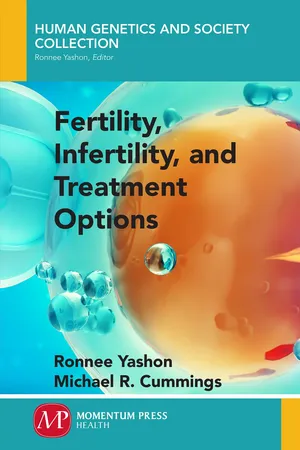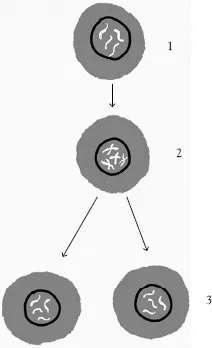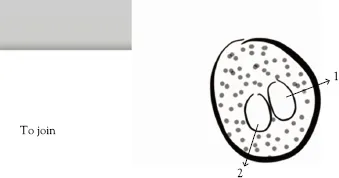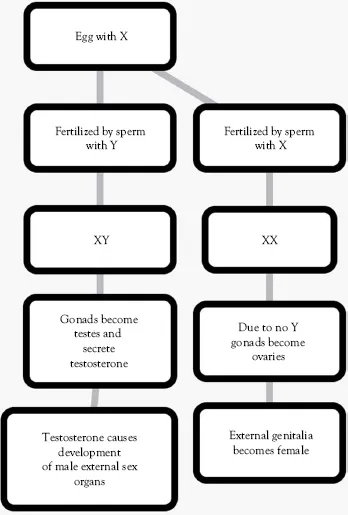
This is a test
- 49 pages
- English
- ePUB (mobile friendly)
- Available on iOS & Android
eBook - ePub
Fertility, Infertility and Treatment Options
Book details
Book preview
Table of contents
Citations
About This Book
It seems simple to create a baby, after all everyone does it. Even simpler is the definition of fertility. For a successful conception, you need only three things: egg, sperm, and uterus. However, all of these components have to work together to produce a healthy baby, but what happens if one of these parts is not working properly, or is missing altogether? In this book, we will be discussing normal fertility, infertility, and treatment developed in the last 30 years to help with a problem that is almost an epidemic in some countries. These treatments, called assisted reproduction for infertility, have led scientists to find ways to place the sperm and egg as close together as possible so that they fuse and begin development of an embryo.
Frequently asked questions
At the moment all of our mobile-responsive ePub books are available to download via the app. Most of our PDFs are also available to download and we're working on making the final remaining ones downloadable now. Learn more here.
Both plans give you full access to the library and all of Perlego’s features. The only differences are the price and subscription period: With the annual plan you’ll save around 30% compared to 12 months on the monthly plan.
We are an online textbook subscription service, where you can get access to an entire online library for less than the price of a single book per month. With over 1 million books across 1000+ topics, we’ve got you covered! Learn more here.
Look out for the read-aloud symbol on your next book to see if you can listen to it. The read-aloud tool reads text aloud for you, highlighting the text as it is being read. You can pause it, speed it up and slow it down. Learn more here.
Yes, you can access Fertility, Infertility and Treatment Options by Ronee Yashon, Michael R. Cummings in PDF and/or ePUB format, as well as other popular books in Biowissenschaften & Genetik & Genomik. We have over one million books available in our catalogue for you to explore.
Information
Topic
BiowissenschaftenSubtopic
Genetik & GenomikCHAPTER 1
Fertilization
Questions (in italics) are scattered throughout this chapter and the following chapters. Watch for them and think about how they may apply to you and the case in Chapter 2.
Cell Division
Mitosis is a form of cell division that produces two daughter cells that are genetically identical to the parent cell. Since each daughter cell carries the same genetic information as the parent cell, the chromosomes are copied before mitosis begins. The process of mitosis is divided into stages defined by the processes completed in each stage. These stages are prophase, prometaphase, metaphase, anaphase, and telophase. During mitosis, the chromosomes coil tightly and become visible. They attach to fibers in the cytoplasm that pull and guide one copy of each chromosome to opposite sides of the cell. After the cell membrane pinches inward, the cytoplasm divides, the nucleus re-forms, and the chromosomes uncoil. The result is two genetically identical daughter cells. A simplified illustration is shown in Figure 1.1.
In the embryo and fetus, mitosis creates new cells that form all the organs and body parts before birth. During infancy and childhood, mitosis produces the cells that contribute to the growth, maturation, and transformation of the child into an adult. In adults, growth takes place, and mitosis is mainly responsible for replacing dead and worn-out cells. In a normal adult, mitosis produces over 200 billion cells every day to maintain the body.
We all begin life as a single cell, the zygote, which results from the fusion of a sperm and egg, an event called fertilization. Gametes, the cells involved with reproduction, are formed in the testes (sperm) and the ovaries (eggs). Cells in the testes and ovaries undergo another form of cell division called meiosis, which reduces the number of chromosomes in the parent cell by half. At the start of meiosis, cells contain two copies of each chromosome, for a total of 46 chromosomes. During meiosis, members of a chromosome pair separate from each other and end up in different cells, resulting in cells with 23 chromosomes. This process involves two rounds of cell division, and is necessary to produce sperm and egg cells for reproduction. Figure 1.2 shows how meiosis occurs.

Figure 1.1 Mitosis. #1: mother cell; #2: duplication of chromosomes; #3: 2 daughter cells. The stages of mitosis are shown: 1. mother cell; 2. chromosome duplicate; 3. daughter cells exact copies of #1.
Reduction division with #1 being the original cell with 46 chromosomes. And #4 being the gametes with 23 chromosomes each.
When the sperm and egg, each carrying 23 chromosomes, fuse together at fertilization, the zygote ends up with a full complement of chromosomes (46). If chromosomes fail to separate properly during meiosis, the gametes can contain too few or too many chromosomes, resulting in an abnormal number of chromosomes in the zygote and the child that develops from this zygote, as shown in Figure 1.3.

Figure 1.2 Cells undergoing meiosis

Figure 1.3 Sperm nucleus (#1) and egg nucleus (#2) are about to join
Formation and Early Development of the Embryo
In the laboratory, we can see how fertilization takes place by adding sperm to a small dish containing an egg. Responding to chemical signals, hundreds of sperm surround the egg, but only one sperm enters the egg. As it does so, its tail remains behind, so only the sperm head containing the chromosomes enters, and all other sperm are chemically blocked from entry and fall away. Inside the egg, the sperm head fuses with the nucleus of the egg, creating a zygote carrying 46 chromosomes. Shortly thereafter, mitosis begins, and the embryo begins to grow.
Fertilization occurs in the fallopian tube (oviduct), and over the next few days, the developing embryo travels down the oviduct to the uterus. Once it reaches the uterus, the embryo nestles into the wall of the uterus, and sends out projections that attach it to the uterus and begin formation of the placenta, through which nutrients are received, and waste materials are exported.
Sex Determination
At this point, let’s pause and talk about how sex is determined in a developing embryo. As we mentioned earlier, cells in humans carry 46 chromosomes, organized into 23 pairs (one member of each pair was donated by the mother, and the other by the father). One of these pairs is called the sex chromosomes (identified as X and Y). Females have two X chromosomes as their sex chromosome pair, and males have an X and a Y chromosome as their pair. These sex chromosomes partially determine the sex of the baby. Follow along with the illustration in Figure 1.4. Females have two X chromosomes, and so after meiosis, each egg contains one X (but which one?). Sperm, however, can have either an X or a Y chromosome, but because during meiosis, only one of chromosomes ends up in each sperm. So that means that sperm can carry either an X or a Y. About half of all sperm created in the testes have an X chromosome, and half have a Y. It doesn’t take a lot of math to realize that this means that the SPERM determines the sex of a baby; an egg can contribute only an X chromosome, while the sperm can contribute either an X or a Y chromosome. For each fertilization, there is a 50 percent chance the zygote will have an XX sex chromosome pair, setting the chromosomal sex of the embryo as female. Of course, there is also a 50 percent chance that the zygote will be XY, making the chromosomal sex of the zygote male (Figure 1.5).

Figure 1.4 Sperm surrounds egg

Figure 1.5 This chart shows the sequence of sex determination
When a baby is born no one looks at the chromosomes but they look at the baby itself and say “congratulations you have a fill in the blank.”
What if we want to have a boy? Can we do this?
Formation of the embryo’s sex organs begins in about the 7th week of development. The sex chromosomes control development of the internal and external sex organs. If a Y chromosome is present, the action of genes on this chromosome stimulates th...
Table of contents
- Cover
- Half-title Page
- Title Page
- Copyright
- Abstract
- Contents
- Introduction
- Chapter 1 Fertilization
- Chapter 2 Infertility
- Chapter 3 Treatment for Infertility
- Chapter 4 Sperm and Egg Donation
- Chapter 5 Surrogacy
- Chapter 6 In Vitro Fertilization (IVF)
- Chapter 7 Problems with ART
- Chapter 8 The Future of ART
- Chapter 9 Landmark Cases
- Chapter 10 What Would You Do?
- References
- Index
- This Title For the Human Genetics and Society Collection
- Backcover